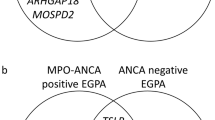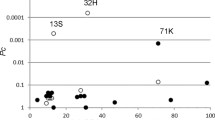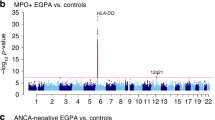Abstract
Microscopic polyangiitis (MPA) is a rare and severe form of systemic necrotizing vasculitis associated with myeloperoxidase (MPO)-specific antineutrophil cytoplasmic antibody (ANCA). We previously reported significant association of HLA-DRB1*0901 with MPA. To define the susceptibility loci within the HLA region, we determined the genotypes of HLA-DQB1, DPB1, B and C in 50 patients with MPA and 77 unrelated Japanese controls. In addition to HLA-DRB1*0901, significant association of DQB1*0303 (allele carrier frequencies 50% in MPA, 29.9% in controls, odds ratio 2.35, P=0.017) was detected. These alleles were in strong linkage disequilibrium (D′=0.95, r2=0.82). Increased frequency was also observed for DPB1*0201, B*15111 and Cw*0303, which was at least partly accounted for by linkage disequilibrium with DRB1*0901 and DQB1*0303. These results indicate that DRB1*0901-DQB1*0303 haplotype represents the primary genetic risk for MPA within the HLA region in Japanese, and provides the basis that future functional studies on the role of HLA in MPA should target DR9, DQ9 and DR53 proteins encoded by this haplotype.
This is a preview of subscription content, access via your institution
Access options
Subscribe to this journal
Receive 6 digital issues and online access to articles
$119.00 per year
only $19.83 per issue
Buy this article
- Purchase on Springer Link
- Instant access to full article PDF
Prices may be subject to local taxes which are calculated during checkout
Similar content being viewed by others
References
Seo P, Stone JH . The antineutrophil cytoplasmic antibody-associated vasculitis. Am J Med 2004; 117: 39–50.
Watts RA, Scott DGI . Epidemiology of the vasculitides. Curr Opin Rheumatol 2003; 15: 11–16.
Csernok E, Trabandt A, Gross WL . Immunogenetic aspects of ANCA-associated vasculitides. Exp Clin Immunogenet 1997; 14: 177–182.
Spencer SJ, Burns A, Gaskin G, Pusey CD, Rees AJ . HLA class II specificities in vasculitis with antibodies to neutrophil cytoplasmic antigens. Kidney Int 1992; 41: 1059–1063.
Gencik M, Borgmann S, Zahn R, Albert E, Sitter T, Epplen JT et al. Immunogenetic risk factors for anti-neutrophil cytoplasmic antibody (ANCA)-associated systemic vasculitis. Clin Exp Immunol 1999; 117: 412–417.
Fujii A, Tomizawa K, Arimura Y, Nagasawa T, Ohashi YY, Hiyama T et al. Epitope analysis of myeloperoxidase (MPO) specific anti-neutrophil cytoplasmic autoantibodies (ANCA) in MPO-ANCA-associated glomerulonephritis. Clin Nephrol 2000; 53: 242–252.
Tse WY, Abadeh S, Jefferis R, Savage CO, Adu D . Neutrophil FcγRIIIb allelic polymorphism in anti-neutrophil cytoplasmic antibody (ANCA)-positive systemic vasculitis. Clin Exp Immunol 2000; 119: 574–577.
Gencik M, Meller S, Borgmann S, Sitter T, Menezes Saecker AM, Fricke H et al. The association of CD18 alleles with anti-myeloperoxidase subtypes of ANCA-associated systemic vasculitides. Clin Immunol 2000; 94: 9–12.
Meller S, Jagiello P, Borgmann S, Fricke H, Epplen JT, Gencik M . Novel SNPs in the CD18 gene validate the association with MPO-ANCA+ vasculitis. Genes Immun 2001; 2: 269–272.
Reynolds WF, Stegeman CA, Tervaert JW . −463 G/A myeloperoxidase promoter polymorphism is associated with clinical manifestations and the course of disease in MPO-ANCA-associated vasculitis. Clin Immunol 2002; 103: 154–160.
Mahr A, Guillevin L, Poissonnet M, Aymé S . Prevalence of polyarteritis nodosa, microscopic polyangiitis, Wegener's granulomatosis, and Churg-Strauss syndrome in a French urban multiethnic population in 2000: a capture-recapture estimate. Arthritis Rheum 2004; 51: 92–99.
Reinhold-Keller E, Herlyn K, Wagner-Bastmeyer R, Gross WL . Stable incidence of primary systemic vasculitides over five years: results from the German vasculitis register. Arthritis Rheum 2005; 53: 93–99.
Matsumoto Y, Nakayama T, Tamakoshi A, Ohno Y, Inaba Y, Kobayashi S et al. Nationwide epidemiological survey of refractory vasculitis (anti-neutrophil cytoplasmic antibody (ANCA)-associated vasculitis, anti-phospholipid syndrome and temporal arteritis) in Japan. 1998 Annual Report of the Research Committee on Intractable Vasculitides, the Ministry of Health, Labour and Welfare of Japan 1999, pp 15–23. (in Japanese, abstract in English).
Tsuchiya N, Kobayashi S, Kawasaki A, Kyogoku C, Arimura Y, Yoshida M et al. Genetic background of Japanese patients with ANCA-associated vasculitis: Association of HLA-DRB1*0901 with microscopic polyangiitis. J Rheumatol 2003; 30: 1534–1540.
Tokunaga K, Ishikawa Y, Ogawa A, Wang H, Mitsunaga S, Moriyama S et al. Sequence-based association analysis of HLA class I and II alleles in Japanese supports conservation of common haplotypes. Immunogenetics 1997; 46: 199–205.
Imanishi T, Akaza T, Kimura A, Tokunaga K, Gojobori T . Allele and haplotype frequencies for HLA and complement loci in various ethnic groups. In: Tsuji K, Aizawa M, Sasazuki T (eds). HLA 1991: Proceedings of the Eleventh International Histocompatibility Workshop and Conference, vol. 1, Oxford University Press: Oxford, 1992, pp 1065–1220.
Matsushita M, Tsuchiya N, Nakayama T, Ohashi J, Shibue T, Shiota M et al. Allele typing of human TNFA 5′-flanking region using PCR-PHFA (preferential homoduplex formation assay): linkage disequilibrium with HLA class I and class II in Japanese. Tissue Antigens 1999; 54: 478–484.
Acknowledgements
The authors are indebted to the patients and healthy donors who participated in this study, to the doctors who recruited the patients, and to Aya Kawasaki (Department of Human Genetics, The University of Tokyo) for technical assistance. This study was supported by the Ministry of Health, Labour, and Welfare, the Ministry of Education, Culture, Sports, Science and Technology of Japan, Japan Society for the Promotion of Science (JSPS), and Takeda Science Foundation.
Author information
Authors and Affiliations
Corresponding author
Rights and permissions
About this article
Cite this article
Tsuchiya, N., Kobayashi, S., Hashimoto, H. et al. Association of HLA-DRB1*0901-DQB1*0303 haplotype with microscopic polyangiitis in Japanese. Genes Immun 7, 81–84 (2006). https://doi.org/10.1038/sj.gene.6364262
Received:
Revised:
Accepted:
Published:
Issue Date:
DOI: https://doi.org/10.1038/sj.gene.6364262
Keywords
This article is cited by
-
Genetics of ANCA-associated vasculitis: role in pathogenesis, classification and management
Nature Reviews Rheumatology (2022)
-
Evolution and molecular interactions of major histocompatibility complex (MHC)-G, -E and -F genes
Cellular and Molecular Life Sciences (2022)
-
The frequency of ANCA-associated vasculitis in a national database of hospitalized patients in China
Arthritis Research & Therapy (2018)
-
HLA and kidney disease: from associations to mechanisms
Nature Reviews Nephrology (2018)
-
Specific HLA genotypes confer susceptibility to acute necrotizing encephalopathy
Genes & Immunity (2016)



